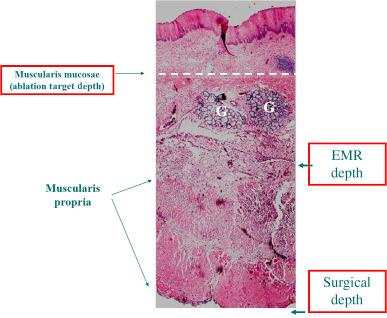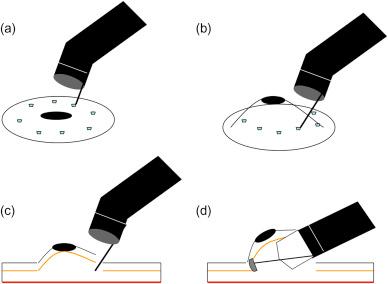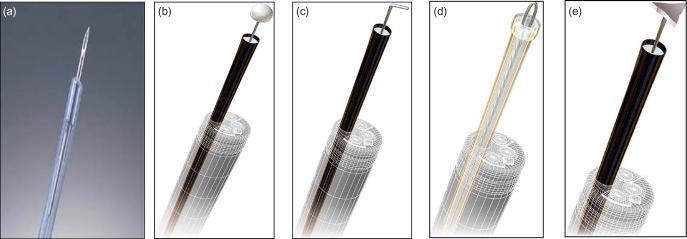Physical Address
304 North Cardinal St.
Dorchester Center, MA 02124
Earlier chapters in this book describe how ablative therapies have essentially replaced surgery for the management of Barrett’s esophagus (BE) with high-grade dysplasia (HGD). However, resectional therapies, performed either with flexible endoscopy or surgery, are still required for managing this disease either as an adjunct to ablation or for definitive therapy. This chapter describes the indications for using resectional therapies in the management of BE, illustrates the available techniques, discusses which option to choose, and explores prevention and management of complications. Surveillance strategies for recurrence following resection of BE are described in a later chapter.
Endoscopic mucosal resection (EMR) and endoscopic submucosal dissection (ESD) are techniques used to resect tissue from within the lumen of the gastrointestinal (GI) tract using a flexible endoscopic platform. Unlike mucosal ablation, which removes the superficial layers of the mucosa only, EMR and ESD resect mucosa through the submucosal layer and down to the muscularis propria ( Fig. 13.1 ). These techniques provide for larger tissue samples and intact pathologic architecture which aid in staging disease, but are also associated with higher risks of perforation, bleeding, and postprocedure stricture.

There are two main methods for performing EMR: nonsuction (“lift-and-cut”) and suction (“suck-and-cut”) techniques. Both techniques begin by marking the planned resection margins with brief bursts of electrosurgery using an endoscopic snare with the wire minimally deployed ( Fig. 13.2 ):
“Lift-and-Cut” technique : The lift-and-cut technique is similar to performing a saline lift polypectomy in the colon ( Fig. 13.3 ) . A sclerotherapy needle is used to inject fluid into the submucosal space to elevate the lesion away from the underlying muscularis propria and create a less flat target for resection. The injection is often done with saline, but other solutions have been used to achieve longer maintenance of the bleb including hypertonic saline (3.75% NaCl), 20% dextrose, or sodium hyaluronate . Indigo carmine (0.004%) or methylene blue is often added to the injectate to stain the submucosa and provides a better evaluation of the depth of resection. The submucosal injection can also be used to determine if a lesion is appropriate for endoscopic resection. Lack of elevation during injection indicates adherence to the muscularis propria and is a relative contraindication to proceeding with EMR. After creating the submucosal elevation, the lesion is grasped with a rat tooth forceps that has been passed through an open polypectomy snare. The forceps lifts the lesion and the snare is pushed down around its base and resection ensues. This “reach-through” technique requires a double lumen endoscope which can be cumbersome to use in the esophagus. As a result, lift-and-cut techniques are used less commonly for esophageal lesions.

“Suck-and-Cut” techniques : This method aspirates the lesion into a cap attached to the tip of the endoscope and then resects it. The most common methods utilize either a cap only (EMR-C) or a cap with an integrated band ligating device (EMR-L). For EMR-C ( Fig. 13.4 ), a specialized cap is fitted to the end of the endoscope providing a chamber for aspiration of mucosa. The lesion may or may not be elevated with a submucosal injection and a crescent shaped snare is mounted into the distal inner rim of the cap. The lesion is then aspirated into the cap and the snare tightened around its base. The snared “pseudopolyp” is then excised. The special EMR caps come in various sizes and shapes, the largest of which is 18 mm in diameter.


When performing EMR-L ( Fig. 13.5 ), submucosal injection may not be required. This technique utilizes a variceal band ligator to ligate the mucosal lesion and create a pseudopolyp. The banded tissue is then simply snare excised either above or below the band.

Both EMR-C and EMR-L are limited in their capacity to accomplish en bloc resection. The maximum diameter amenable to one-piece excision is approximately 20 mm. If multiple resections are required, they should be accomplished at the initial setting if possible as submucosal lift may not be attainable once scar tissue has formed.
ESD allows for larger en bloc resections and begins similar to EMR by marking the periphery of the lesion with small electrosurgery burns. A margin of at least 5 mm is planned and marks are placed approximately every 2 mm ( Fig. 13.6a ). A submucosal injection is then accomplished around the periphery of the lesion utilizing a solution such as sodium hyaluronate with Indigo carmine so that the elevation will persist throughout the procedure ( Fig. 13.6b ). A circumferential incision is then made to isolate the lesion using an ESD electrosurgical knife ( Fig. 13.6c and d ). There are a number of ESD knifes to choose from ( Fig. 13.7 ):
Needle knife : This knife has a fine tip and small contact area that allows sharp incision. Because of its sharp nature, it can easily cause perforation if not controlled carefully. Mucosal incisions are usually begun with a needle knife, but then a switch is made to a protected tip knife to minimize the risk of perforation.
IT knife : The insulated tip knife is a needle knife with the tip covered by a ceramic ball. This blunt, nonthermal tip reduces the risk of perforation. A second generation IT knife has a conducting surface on the bottom of the ball tip to allow for better tissue division when drawing back on the knife.
Hook knife : This is a needle knife with the distal 1 mm of the tip bent at a right angle. The knife also rotates for optimal positioning.
Flex knife : This knife has a rounded tip made of a twisted wire like a snare. Its length can be adjusted as needed. The shaft of the catheter is flexible with a thickened tip that acts as a tissue stop to minimize the chance of perforation.
Triangle tip knife : Has a triangular conductive tip that facilitates cutting mucosa. This knife was designed to be used for all parts of the ESD procedure.
Hybrid knife : A specialized tool that permits submucosal injection, fulguration, and cutting with one device. This device may permit the endoscopist a more efficient device for ESD.


Once the circumferential incision is complete, additional solution is injected into the submucosa in the center to obtain a more complete lift. One of the ESD knives is then used to excise the lesion in the submucosal plane. Meticulous hemostasis is critical in order to facilitate visualization, and the lesion is often positioned opposite the ground to utilize gravity to clear the field. A transparent hood is mounted on the end of the endoscope to facilitate visualization and dissection into the submucosal plane.
For BE, EMR and ESD may be used for circumferential resection. EMR is done piecemeal as described earlier. ESD elevates the mucosa off the underlying muscularis propria and then excises a “sleeve” of esophageal mucosa over the desired length.
Become a Clinical Tree membership for Full access and enjoy Unlimited articles
If you are a member. Log in here